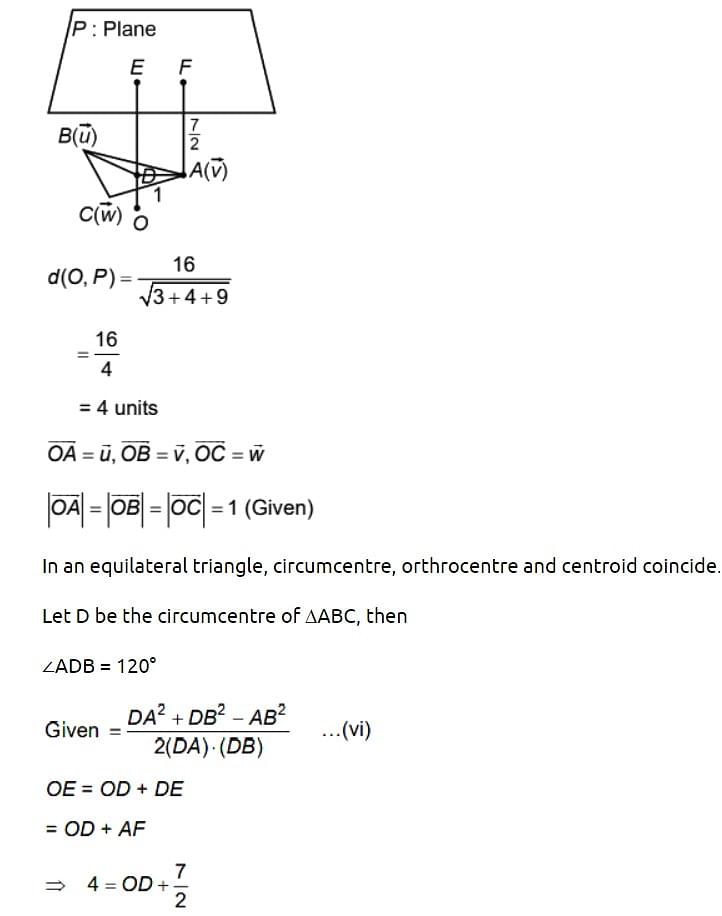Let P be the plane √3x+2y+3z =16 and let and let S = {\(\alpha \hat{i}+\beta \hat{j}+\gamma\hat{k}:\alpha^2+\beta^2+\gamma^2=1\) and the distance of (α, β, γ) from the plane P is \(\frac{7}{2}\) }. Let u, v, and w be three distinct vectors in s such that |\(\vec{u}-\vec{v}\)| = |\(\vec{v}-\vec{w}\)| = |\(\vec{w}-\vec{u}\)|. Let V be the volume of the parallelepiped determined by vectors \(\vec{u},\vec{v},\vec{w}\). Then the value of \(\frac{80}{\sqrt3}\)V is
Approach Solution - 1
Volume of Parallelepiped Determined by Vectors
Let \( P \) be the plane defined by the equation:
\[ \sqrt{3}x + 2y + 3z = 16 \]
Let \( S \) be the set of vectors \( \mathbf{S} = \{\alpha \hat{i} + \beta \hat{j} + \gamma \hat{k} : \alpha^2 + \beta^2 + \gamma^2 = 1 \} \) and the distance of \( (\alpha, \beta, \gamma) \) from the plane \( P \) is given as \( \frac{7}{2} \).
Let \( u, v, \) and \( w \) be three distinct vectors in \( S \) such that:
\[ | \mathbf{u} - \mathbf{v} | = | \mathbf{v} - \mathbf{w} | = | \mathbf{w} - \mathbf{u} | \]
The quantity \( V \) represents the volume of the parallelepiped determined by the vectors \( \mathbf{u}, \mathbf{v}, \mathbf{w} \). The value of \( 80V \) is given as:
\[ \boxed{45} \]
Approach Solution -2
The correct answer will be 45 





Top Questions on Plane
- Let R be the relation "is congruent to" on the set of all triangles in a plane. Is R:
- Let the acute angle bisector of the two planes \( x - 2y - 2z + 1 = 0 \) and \( 2x - 3y - 6z + 1 = 0 \) be the plane \( P \). Then which of the following points lies on \( P \)?
- Let the foot of perpendicular from a point \( P(1,2,-1) \) to the straight line \( L : \frac{x}{1} = \frac{y}{0} = \frac{z}{-1} \) be \( N \). Let a line be drawn from \( P \) parallel to the plane \( x + y + 2z = 0 \) which meets \( L \) at point \( Q \). If \( \alpha \) is the acute angle between the lines \( PN \) and \( PQ \), then \( \cos \alpha \) is equal to:
- If the plane \[ x - y + z + 4 = 0 \] divides the line joining the points \[ P(2,3,-1) \quad {and} \quad Q(1,4,-2) \] in the ratio \( l:m \), then \( l + m \) is:
- The equation of the plane passing through the point \( (1, 1, 1) \) and perpendicular to the planes \( 2x + y - 2z = 5 \) and \( 3x - 6y - 2z = 7 \) is:
Questions Asked in JEE Advanced exam
- Let $$ \alpha = \frac{1}{\sin 60^\circ \sin 61^\circ} + \frac{1}{\sin 62^\circ \sin 63^\circ} + \cdots + \frac{1}{\sin 118^\circ \sin 119^\circ}. $$ Then the value of $$ \left( \frac{\csc 1^\circ}{\alpha} \right)^2 $$ is \rule{1cm}{0.15mm}.
- JEE Advanced - 2025
- Some Applications of Trigonometry
The solubility of barium iodate in an aqueous solution prepared by mixing 200 mL of 0.010 M barium nitrate with 100 mL of 0.10 M sodium iodate is $X \times 10^{-6} \, \text{mol dm}^{-3}$. The value of $X$ is ------.
Use: Solubility product constant $(K_{sp})$ of barium iodate = $1.58 \times 10^{-9}$- JEE Advanced - 2025
- Law Of Chemical Equilibrium And Equilibrium Constant
- At 25$^\circ$C, the concentration of H$^+$ ions in $ 1.00 \times 10^{-3} \, \text{M} $ aqueous solution of a weak monobasic acid having acid dissociation constant $ K_a = 4.00 \times 10^{-11} $ is $ X \times 10^{-7} \, \text{M} $. The value of $ X $ is ____. {Use: Ionic product of water $ K_w = 1.00 \times 10^{-14} $ at 25$^\circ$C
- JEE Advanced - 2025
- Ionic Equilibrium
- Let $ x_0 $ be the real number such that $ e^{x_0} + x_0 = 0 $. For a given real number $ \alpha $, define $$ g(x) = \frac{3xe^x + 3x - \alpha e^x - \alpha x}{3(e^x + 1)} $$ for all real numbers $ x $. Then which one of the following statements is TRUE?
- JEE Advanced - 2025
- Fundamental Theorem of Calculus
- A projectile of mass 200 g is launched in a viscous medium at an angle $60^\circ$ with the horizontal, with an initial velocity of 270 m/s. It experiences a viscous drag force $\vec{F} = -c \vec{v}$ where the drag coefficient $c = 0.1 \, \text{kg/s}$ and $\vec{v}$ is the instantaneous velocity of the projectile. The projectile hits a vertical wall after 2 s. Taking $e = 2.7$, the horizontal distance of the wall from the point of projection (in m) is ____
- JEE Advanced - 2025
- Projectile motion
Concepts Used:
Plane
A surface comprising all the straight lines that join any two points lying on it is called a plane in geometry. A plane is defined through any of the following uniquely:
- Using three non-collinear points
- Using a point and a line not on that line
- Using two distinct intersecting lines
- Using two separate parallel lines
Properties of a Plane:
- In a three-dimensional space, if there are two different planes than they are either parallel to each other or intersecting in a line.
- A line could be parallel to a plane, intersects the plane at a single point or is existing in the plane.
- If there are two different lines that are perpendicular to the same plane then they must be parallel to each other.
- If there are two separate planes which are perpendicular to the same line then they must be parallel to each other.